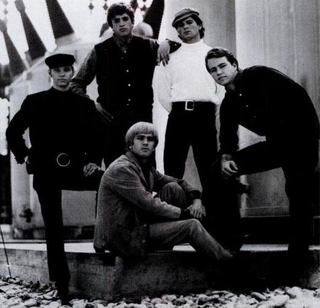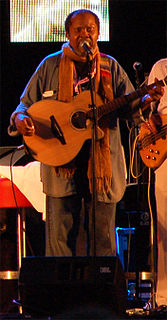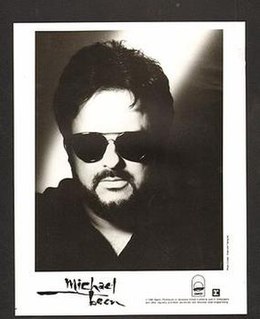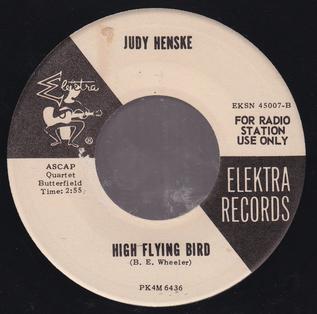
The Electric Prunes are an American psychedelic rock band, formed in Los Angeles, California, in 1965. Much of the band's music was, as music historian Richie Unterberger described it, possessed of "an eerie and sometimes anguished ambiance." It mainly consisted of material by songwriters Annette Tucker and Nancie Mantz, though the group also penned their own songs. Incorporating psychedelia and elements of embryonic electronic rock, the band's sound was marked by innovative recording techniques with fuzz-toned guitars and oscillating sound effects. In addition, guitarist Ken Williams' and singer James Lowe's concept of "free-form garage music" provided the band with a richer sonic palette and exploratory lyrical structure than many of their contemporaries.

The Beau Brummels were an American rock band. Formed in San Francisco in 1964, the band's original lineup included Sal Valentino, Ron Elliott, Ron Meagher, Declan Mulligan, and John Petersen (drums). They were discovered by local disc jockeys who were looking to sign acts to their new label, Autumn Records, where Sylvester Stewart—later known as Sly Stone—produced the group's early recording sessions. Initially, the band's musical style blended beat music and folk music and typically drew comparisons to the Beatles, while their later work incorporated other music genres such as psychedelic rock and country rock.
Dunwich Records was an independent American record label started by Bill Traut, Eddie Higgins and George Badonsky in Chicago in 1965. Dunwich was also a production company which licensed recordings to other labels, including Atlantic, Atco, Columbia, Mercury and SGC. The label was primarily known for the release of singles from the emerging Chicago rock scene in the 1960s. Only two artists, the Shadows of Knight and Amanda Ambrose, released albums on the label.

Psychedelic Shack is the twelfth studio album by The Temptations for the Gordy (Motown) label released in 1970, which represents the Temptations' full-blown submergence into psychedelia. Completely written by Norman Whitfield and Barrett Strong and produced by Whitfield, Psychedelic Shack almost completely abandoned the "Motown Sound" formula for this LP; hard rock guitars, synthesizer sound effects, multitracked drums, and stereo-shifting vocals giving most of the album's songs a harder, less traditional feel than the Temptations' previous work. Along with the hit title track, the album also features the group's original version of "War", which became a major hit for Edwin Starr later in 1970.

Bardo Pond are an American psychedelic rock band formed in 1991, and who are currently signed to London-based label Fire Records. The current members are Michael Gibbons (guitar), John Gibbons (guitar), Isobel Sollenberger, Clint Takeda and Jason Kourkounis (drums). Bardo Pond's music is often classified as space rock, acid rock, post-rock, shoegazing, noise or psychedelic rock. Some Bardo Pond album titles have been derived from the names of esoteric psychedelic substances. Their sound has been likened to Pink Floyd, Spacemen 3 and My Bloody Valentine amongst others.

Terrence Orlando "Terry" Callier was an American soul, folk and jazz guitarist and singer-songwriter.

The Buckinghams are an American sunshine pop band from Chicago. They formed in 1966 and went on to become one of the top-selling acts of 1967, charting their only five top 40 hits in the U.S. that year. The band dissolved in 1970, but re-formed in 1980 and as of 2019 they continue to tour throughout the United States.

H. P. Lovecraft was an American psychedelic rock band, formed in Chicago, Illinois, in 1967 and named after the horror writer H. P. Lovecraft. Much of the band's music was possessed of a haunting, eerie ambience, and consisted of material that was inspired by the macabre writings of the author whose name they had adopted. Combining elements of psychedelia and folk rock, the band's sound was marked by the striking vocal harmonies of ex-folk singer George Edwards and the classically trained Dave Michaels. In addition, Michaels' multi-instrumentalist abilities on organ, piano, harpsichord, clarinet and recorder provided the band with a richer sonic palette than many of their contemporaries.
Charles Ethan Kenning is an American singer, songwriter and musician who performed as George Edwards when he led 1960s acid rock band, H. P. Lovecraft. He was adopted as a child and brought up under the name George Edwards. He reverted to his birth name of Ethan Kenning in his mid-30s.
Jerry McGeorge came to prominence in late 1965 as an American guitarist with the Chicago rock band The Shadows of Knight. He later joined the psychedelic rock band H.P. Lovecraft on bass in the summer of 1967, appearing on their debut album, H. P. Lovecraft.
David Miotke is an American keyboard player and singer, who under the name Dave Michaels, was best known as co-founder of the '60s acid rock band H. P. Lovecraft.
The Shag were an American garage and psychedelic rock band in the 1960s, best known for their 1967 single "Stop and Listen". They were one of numerous bands at the time using the name "The Shags".

Live May 11, 1968 is a live album by the American psychedelic rock band H. P. Lovecraft and was released in 1991. The eight tracks included on the album were all recorded at The Fillmore in San Francisco, California, on May 11, 1968, soon after the band's original bass player Jerry McGeorge had been replaced by Jeffrey Boyan. The album consists of material taken from the band's first two studio albums and features very good sound quality considering the era in which it was recorded.

H. P. Lovecraft II is the second album by the American psychedelic rock band H. P. Lovecraft and was released in September 1968 on Philips Records. As with their debut LP, the album saw the band blending psychedelic and folk rock influences, albeit with a greater emphasis on psychedelia than on their first album. H. P. Lovecraft II failed to sell in sufficient quantities to reach the Billboard Top LPs chart or the UK Albums Chart, despite the band being a popular act on the U.S. psychedelic concert circuit. Legend has it that the album was the first major label release to have been recorded by musicians who were all under the influence of LSD.

Michael Kenneth Been was an American rock musician who achieved critical attention and rotation play on MTV in the 1980s with his band The Call. He later released an album of his solo work and toured with his son's band Black Rebel Motorcycle Club. His song "Let the Day Begin" was the official campaign song of Al Gore's 2000 U.S. presidential campaign. His song "Oklahoma" was one of the top ten choices for Oklahoma's official state rock song and a line from the song provided the name for Another Hot Oklahoma Night: A Rock & Roll Exhibit at the Oklahoma History Center.
Aorta were an American psychedelic rock band from Chicago who recorded two albums in the late 1960s and early 1970s.

"Get Me to the World on Time" is a song written by Annette Tucker and Jill Jones for the American garage rock band, The Electric Prunes. The song was released in May 1967 following the success of the band's previous single, "I Had Too Much to Dream ". Although the follow-up did not have the same success, "Get Me to the World on Time" still charted at number 27 on the Billboard Hot 100. The single also fared slightly better in the UK, where it reached number 42.
"The White Ship" is a song released by the American psychedelic rock band, H. P. Lovecraft, in November 1967. The songwriting is credited to band members George Edwards, Dave Michaels, and Tony Cavallari. Acting as the opening song on the second side of their debut LP, H. P. Lovecraft, it was the album's longest track, and an edited version was also released as the band's second single. The name and theme of the song derive directly from author H. P. Lovecraft's short story, "The White Ship". Despite its failure to chart nationally, it is widely considered to be H. P. Lovecraft's most accomplished piece, and helped establish the group, who were originally from Chicago, in the West Coast music scene.
William Raymond Traut was an American jazz musician, rock music producer, manager and record label executive. He co-founded the Dunwich and Wooden Nickel record labels, and produced The Shadows of Knight, The American Breed, the Siegel-Schwall Band, and Styx, among others.

"High Flying Bird" is a song written by American folk and country singer-songwriter Billy Edd Wheeler, and first recorded by Judy Henske in 1963. It was performed and recorded by many musicians and groups in the mid and late 1960s, and was influential on the folk rock genre.












